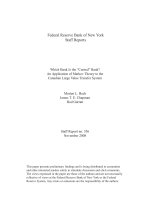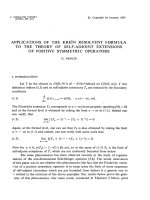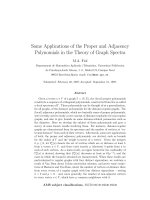Applications of group theory to
Bạn đang xem bản rút gọn của tài liệu. Xem và tải ngay bản đầy đủ của tài liệu tại đây (6.58 MB, 485 trang )
www.pdfgrip.com
A P P L I C AT I O N S O F G RO U P T H E O RY TO ATO M S ,
MOLECULES, AND SOLIDS
The majority of all knowledge concerning atoms, molecules, and solids has
been derived from applications of group theory. Taking a unique, applicationsoriented approach, this book gives readers the tools needed to analyze any atomic,
molecular, or crystalline solid system.
Using a clearly defined, eight-step program, this book helps readers to understand the power of group theory, what information can be obtained from it, and how
to obtain it. The book takes in modern topics, such as graphene, carbon nanotubes,
and isotopic frequencies of molecules, as well as more traditional subjects: the
vibrational and electronic states of molecules and solids, crystal-field and ligandfield theory, transition-metal complexes, space groups, time-reversal symmetry,
and magnetic groups.
With over a hundred end-of-chapter exercises, this book is invaluable for graduate students and researchers in physics, chemistry, electrical engineering, and
materials science.
is a former Chairman and Professor of the Department
of Physics and Astronomy, University of Missouri-Columbia. He has founded a
science and technology laboratory for a major company and started a company
that manufactured diode-pumped, fiber-optic transmitters and amplifiers.
THOMAS WOLFRAM
˘ LU
S¸ ˙I N A S ˙I E L L ˙I A LT I O G
is a former Chairman and Professor of Physics at the
Middle East Technical University in Ankara, Turkey. He has been a recipient of
Humboldt and Fulbright Fellowships. Currently he is a Professor of Physics and
Director of Basic Sciences at TED University in Ankara.
www.pdfgrip.com
www.pdfgrip.com
AP P LI CATI ONS O F GROUP T HE ORY
TO ATOMS, MOLECULES,
AND S O L IDS
THOMAS WOLFRAM
Formerly of the University of Missouri-Columbia
˘
S¸ ˙INAS ˙I E L L ˙I ALT I O GLU
TED University, Ankara
Formerly of Middle East Technical University, Ankara
www.pdfgrip.com
University Printing House, Cambridge CB2 8BS, United Kingdom
Published in the United States of America by Cambridge University Press, New York
Cambridge University Press is part of the University of Cambridge.
It furthers the University’s mission by disseminating knowledge in the pursuit of
education, learning, and research at the highest international levels of excellence.
www.cambridge.org
Information on this title: www.cambridge.org/9781107028524
c T. Wolfram and S.
¸ Ellialtıo˘glu 2014
This publication is in copyright. Subject to statutory exception
and to the provisions of relevant collective licensing agreements,
no reproduction of any part may take place without the written
permission of Cambridge University Press.
First published 2014
Printed in the United Kingdom by CPI Group Ltd, Croydon CR0 4YY
A catalogue record for this publication is available from the British Library
Library of Congress Cataloguing in Publication data
Wolfram, Thomas, 1936–
Applications of group theory to atoms, molecules, and solids / Thomas Wolfram, Sinasi
¸
Ellialtıo˘glu.
pages cm
ISBN 978-1-107-02852-4 (hardback)
1. Solids – Mathematical models. 2. Molecular structure. 3. Atomic structure. 4. Group theory.
I. Title.
QC176.W65 2013
530.4 1015122–dc23
2013008434
ISBN 978-1-107-02852-4 Hardback
Cambridge University Press has no responsibility for the persistence or
accuracy of URLs for external or third-party internet websites referred to
in this publication, and does not guarantee that any content on such
websites is, or will remain, accurate or appropriate.
www.pdfgrip.com
Contents
Preface
page xi
1 Introductory example: Squarene
1.1 In-plane molecular vibrations of squarene
1.2 Reducible and irreducible representations of a group
1.3 Eigenvalues and eigenvectors
1.4 Construction of the force-constant matrix from the
eigenvalues
1.5 Optical properties
References
Exercises
1
1
12
27
2 Molecular vibrations of isotopically substituted AB2 molecules
2.1 Step 1: Identify the point group and its symmetry operations
2.2 Step 2: Specify the coordinate system and the basis functions
2.3 Step 3: Determine the effects of the symmetry operations on
the basis functions
2.4 Step 4: Construct the matrix representations for each element
of the group using the basis functions
2.5 Step 5: Determine the number and types of irreducible
representations
2.6 Step 6: Analyze the information contained in the
decompositions
2.7 Step 7: Generate the symmetry functions
2.8 Step 8: Diagonalize the matrix eigenvalue equation
2.9 Constructing the force-constant matrix
2.10 Green’s function theory of isotopic molecular vibrations
2.11 Results for isotopically substituted forms of H2 O
39
39
39
30
31
34
35
41
41
42
42
43
50
50
52
60
v
www.pdfgrip.com
vi
Contents
References
Exercises
62
62
3 Spherical symmetry and the full rotation group
3.1 Hydrogen-like orbitals
3.2 Representations of the full rotation group
3.3 The character of a rotation
3.4 Decomposition of D (l) in a non-spherical environment
3.5 Direct-product groups and representations
3.6 General properties of direct-product groups and representations
3.7 Selection rules for matrix elements
3.8 General representations of the full rotation group
References
Exercises
66
66
68
72
75
76
79
83
85
88
88
4 Crystal-field theory
4.1 Splitting of d-orbital degeneracy by a crystal field
4.2 Multi-electron systems
4.3 Jahn–Teller effects
References
Exercises
90
90
95
116
119
119
5 Electron spin and angular momentum
5.1 Pauli spin matrices
5.2 Measurement of spin
5.3 Irreducible representations of half-integer angular
momentum
5.4 Multi-electron spin–orbital states
5.5 The L–S-coupling scheme
5.6 Generating angular-momentum eigenstates
5.7 Spin–orbit interaction
5.8 Crystal double groups
5.9 The Zeeman effect (weak-magnetic-field case)
References
Exercises
123
123
126
6 Molecular electronic structure: The LCAO model
6.1 N-electron systems
6.2 Empirical LCAO models
6.3 Parameterized LCAO models
6.4 An example: The electronic structure of squarene
6.5 The electronic structure of H2 O
158
158
162
163
168
182
www.pdfgrip.com
127
129
130
132
138
150
153
155
156
Contents
References
Exercises
vii
188
189
7 Electronic states of diatomic molecules
7.1 Bonding and antibonding states: Symmetry functions
7.2 The “building-up” of molecular orbitals for diatomic
molecules
7.3 Heteronuclear diatomic molecules
Exercises
193
193
8 Transition-metal complexes
8.1 An octahedral complex
8.2 A tetrahedral complex
References
Exercises
211
211
227
237
237
9 Space groups and crystalline solids
9.1 Definitions
9.2 Space groups
9.3 The reciprocal lattice
9.4 Brillouin zones
9.5 Bloch waves and symmorphic groups
9.6 Point-group symmetry of Bloch waves
9.7 The space group of the k-vector, gsk
9.8 Irreducible representations of gsk
9.9 Compatibility of the irreducible representations of gk
9.10 Energy bands in the plane-wave approximation
References
Exercises
239
239
244
246
247
249
252
258
259
260
265
276
276
10 Application of space-group theory: Energy bands for the perovskite
structure
10.1 The structure of the ABO3 perovskites
10.2 Tight-binding wavefunctions
10.3 The group of the wavevector, gk
10.4 Irreducible representations for the perovskite energy bands
10.5 LCAO energies for arbitrary k
10.6 Characteristics of the perovskite bands
References
Exercises
280
280
282
283
284
298
300
301
302
www.pdfgrip.com
198
206
209
viii
Contents
11 Applications of space-group theory: Lattice vibrations
11.1 Eigenvalue equations for lattice vibrations
11.2 Acoustic-phonon branches
11.3 Optical branches: Two atoms per unit cell
11.4 Lattice vibrations for the perovskite structure
11.5 Localized vibrations
References
Exercises
304
305
309
314
320
327
334
334
12 Time reversal and magnetic groups
12.1 Time reversal in quantum mechanics
12.2 The effect of T on an electron wavefunction
12.3 Time reversal with an external field
12.4 Time-reversal degeneracy and energy bands
12.5 Magnetic crystal groups
12.6 Co-representations for groups with time-reversal operators
12.7 Degeneracies due to time-reversal symmetry
References
Exercises
337
337
340
341
342
346
350
357
361
361
13 Graphene
13.1 Graphene structure and energy bands
13.2 The analogy with the Dirac relativistic theory for massless
particles
13.3 Graphene lattice vibrations
References
Exercises
363
363
14 Carbon nanotubes
14.1 A description of carbon nanotubes
14.2 Group theory of nanotubes
14.3 One-dimensional nanotube energy bands
14.4 Metallic and semiconducting nanotubes
14.5 The nanotube density of states
14.6 Curvature and energy gaps
References
Exercises
383
384
386
393
401
403
406
407
407
Appendix A
Vectors and matrices
410
Appendix B
Basics of point-group theory
415
www.pdfgrip.com
368
369
381
381
Contents
ix
Appendix C
Character tables for point groups
430
Appendix D
Tensors, vectors, and equivalent electrons
442
Appendix E
The octahedral group, O and Oh
449
Appendix F
The tetrahedral group, Td
455
Appendix G
Identifying point groups
462
Index
465
www.pdfgrip.com
www.pdfgrip.com
Preface
The majority of all knowledge accumulated in physics and chemistry concerning
atoms, molecules, and solids has been derived from applications of group theory to
quantum systems.
My (T.W.) first encounter with group theory was as an undergraduate in physics,
struggling to understand Wigner’s Group Theory and Its Application to the Quantum Mechanics of Atomic Spectra (1959). I felt there was something magical about
the subject. It was amazing to me that it was possible to analyze a physical system
knowing only the symmetry and obtain results that were absolute, independent of
any particular model. To me it was a miracle that it was possible to find some exact
eigenvectors of a Hamiltonian by simply knowing the geometry of the system or
the symmetry of the potential.
Many books devote the initial chapters to deriving abstract theorems before discussing any of the applications of group theory. We have taken a different approach.
The first chapter of this book is devoted to finding the molecular vibration eigenvalues, eigenvectors, and force constants of a molecule. The theorems required to
accomplish this task are introduced as needed and discussed, but the proofs of the
theorems are given in the appendices. (In later chapters the theorems needed for the
analysis are derived within the discussions.) By means of this applications-oriented
approach we are able to immediately give a general picture of how group theory is
applied to physical systems. The emphasis is on the process of applying group theory. The various steps needed to analyze a physical system are clearly delineated.
By the end of the first chapter the reader should have an appreciation for the power
of group theory, what information can be obtained, and how to obtain it. That is,
the “magic” of group theory should already be apparent.
In addition to the essential, traditional topics, there are new topics, including
the electronic and vibrational properties of graphene and nanotubes, the vibrations of isotopically substituted molecules, localized vibrations, and discussions of
the axially symmetric lattice dynamics model. The energy bands and vibrational
xi
www.pdfgrip.com
xii
Preface
normal modes of crystals with the perovskite structure are also discussed in
detail.
The material in this book was developed in part from group-theory courses and
from a series of lectures presented in courses on special topics at the University of
Missouri-Columbia. It is appropriate for science and engineering graduate students
and advanced undergraduate seniors. The ideal reader will have had a course in
quantum mechanics and be familiar with eigenvalue problems and matrix algebra.
However, no prerequisite knowledge of group theory is necessary.
This book may be employed as a primary text for a first course in group theory or as an auxiliary book for courses in quantum mechanics, solid-state physics,
physical chemistry, materials science, or electrical engineering. It is intended as a
self-teaching tool and therefore the analyses in the early chapters are given in some
detail. Each chapter includes a set of exercises designed to reinforce and extend the
material discussed in the chapter.
Thomas Wolfram
and
Sinasi
¸
Ellialtıo˘glu
www.pdfgrip.com
1
Introductory example: Squarene
In this chapter we illustrate the solution of a simple physical problem in order to
familiarize the reader with the procedures used in the group-theoretical analysis.
Since this is the initial chapter, we shall give nearly all of the details involved in
the analysis. Some readers familiar with group theory may find that the discussion
includes too much detail, but we would rather be clear than brief. In later chapters
less detail will be required since the reader will by then be familiar with the analysis
method.
Theorems from group theory are stated and discussed when employed in the
analysis, but the proofs of the theorems are not presented in this chapter. Readers interested in the proofs can find them in Appendix B or refer to a number of
excellent standard group-theory texts [1.1].
The procedures employed in this chapter are simple but somewhat tedious and
not the most efficient way to analyze the simple example discussed. However, these
procedures will prove extremely valuable when we are faced with more complex
problems. Therefore the reader is encouraged to work through the details of the
chapter and the exercises at the end of the chapter.
1.1 In-plane molecular vibrations of squarene
As an introductory example we consider a fictitious square molecule we shall call
“squarene”. The squarene molecule, shown in Fig. 1.1, lies in the plane of the paper
with identical atoms at each corner of a square. Our aim in this chapter is to use
group theory to assist in determining the vibrational frequencies and motions of
the normal modes (eigenvalues and eigenvectors) of the molecule.
In general the molecular vibration problem may be cast into the form of a matrix
eigenvalue problem,
F ξ = ω2 M ξ,
1
www.pdfgrip.com
2
Introductory example: Squarene
4
3
1
2
Figure 1.1 The squarene molecule.
where F is a matrix of “force constants” and ξ is a column vector whose components are the vibrational displacements of the atoms. The matrix M is a diagonal
mass matrix, Mi j = m i δi j where m i is the mass of the atom with coordinate
component ξi and ω is the angular frequency of vibration. This equation may be
transformed to a standard eigenvalue form,
F η = ω2 η,
with F = M−1/2 F M−1/2 and η = M1/2 ξ .
In the case of squarene all the masses are the same, so M can be replaced by a
scalar, m, the common mass of the four atoms. Therefore the eigenvalue equation
we are concerned with is the 8 × 8 matrix equation
F ξ = mω2 ξ.
(1.1)
Solutions of (1.1) consist of a set of eight eigenvalues, m(ωk )2 , and a set of eight
associated eigenvectors, ξ k (k = 1, 2, . . ., 8), that specify the relative displacements
of the atoms. The solutions of (1.1) will include three “body modes”, namely translation in the x-direction, translation in the y-direction, and rotation about an axis
perpendicular to the plane of the molecule at the center of the square. The angular
frequencies of these three body modes may be taken as zero because there are no
“restoring forces” when a molecule is translated or rotated as a unit. Therefore, for
our two-dimensional squarene molecule there will be five vibrational modes and
three zero-frequency, body modes.
One approach to the molecular vibrations of squarene would be to postulate a
force-constant model, F, and solve the resulting eigenvalue problem. In its most
general form, F will have 64 non-zero matrix elements. If no simplifications are
made, the diagonalization of an 8 × 8 matrix could be daunting without the use of
a computer. If approximations are employed to simplify F, it will not be evident
whether the results are constrained by symmetry or by the assumptions made in the
postulated force-constant model. The use of group theory not only greatly simplifies the analysis, but also yields the most general form possible for F and provides
physical insight into the nature of the normal modes of vibration.
www.pdfgrip.com
1.1 In-plane molecular vibrations of squarene
3
Often, the normal-mode frequencies can be measured by spectroscopic means;
infrared or Raman spectroscopy, for example. However, the force constants (the
matrix elements of F) can not be measured directly. They are usually inferred
by using a specific model and choosing the constants so that the eigenfrequencies
match the observed frequencies. This method does not always produce a unique set
of force constants, and other spectroscopic data must be employed; for example,
the frequencies of isotopically substituted molecules and/or elastic constants.
In Chapter 2 we shall investigate how group theory can be used to predict
isotopic frequency shifts. In fact, in some cases the frequencies of an isotopic molecule can be expressed in terms of frequencies of the non-isotopic molecule [1.2]
without ever having to specify the force-constant matrix.1
There is a general order to the way in which group theory is employed to analyze an eigenvalue problem. We shall label the various steps as “Step 1” through
“Step 8”.
1.1.1 Step 1: Identify the point group and its symmetry operations
At rest, the squarene molecule has the symmetry of a square. For simplicity we
confine our discussion to the two dimensions of the plane of the molecule. (There
is no loss of generality in this assumption because the in-plane vibrational modes
do not mix with the motions perpendicular to the plane of the molecule (see Exercise 1.16).) The operations that rotate or reflect an object into a configuration
indistinguishable from its original configuration are called the covering operations and constitute a group. For squarene these operations are rotations about an
axis perpendicular to the plane of the molecule and reflections through lines in the
plane of the molecule. For example we can rotate the square by 90 degrees or any
multiple of 90 degrees about an axis perpendicular to the plane passing through
the center of the square. So there are four rotations: 90-degree, 180-degree, 270degree, and 360-degree rotations. Rotation by 360 degrees is taken to be the same
as “doing nothing”. The “doing-nothing” operation is usually called the “identity”
operation and denoted by the symbol E. There are seven other symmetry operations. If we draw a diagonal line across the square and reflect the corners through
this line, the square remains unchanged. There are two different diagonal lines that
pass through the center and two corners of the square. Another pair of reflection
lines passes through the middle of the square and bisects two opposite sides. These
symmetry operations are shown schematically in Fig. 1.2. The point group corresponding to these operations is “C4v ”. (In three dimensions the group is D4h .
1 Assuming harmonic motions and neglecting very small changes in the force constants due to isotope
substitution.
www.pdfgrip.com
4
Introductory example: Squarene
(a)
4
3
(b)
C4, C2, C43
E
1
2
(c)
(d)
σv1
(e)
σv2
σd1
(f)
σd2
Figure 1.2 The squarene molecule and its symmetry elements.
Methods for identifying the group of a molecule are discussed in Appendix G.) For
C4v there are in total eight symmetry elements.2
(1)
(2)
(3)
(4)
(5)
(6)
(7)
(8)
E = a 0-degree or 360-degree rotation.
C4 = a 90-degree rotation.
C2 = a 180-degree rotation.
C43 = a 270-degree rotation.
σv1 = reflection in a diagonal line.
σv2 = reflection in a diagonal line.
σd1 = reflection in a line cutting the sides of the square.
σd2 = reflection in a line cutting the sides of the square.
For the remainder of this chapter we shall regard the symbols E, C4 , σv1 etc. as
symmetry operators that act on the molecule, not the coordinate system.3 Thus, for
example C4 rotates the molecule and its nuclear displacement by 90 degrees in a
clockwise manner.
The formal definition of a group is given in Theorem 1.1.
2 Inversion through the center of the square (i.e., r → −r) is a symmetry operation. However, the effect of
inversion is the same as the effect of a C2 rotation in this case and so may be omitted.
3 There is a distinction between the symmetry elements and the symmetry operators, but the group of the
operators is isomorphic to the group of the elements, which means that the two groups are equivalent group
theoretically.
www.pdfgrip.com
1.1 In-plane molecular vibrations of squarene
5
Theorem 1.1 (Definition of a group)
1. A group is a set of elements that are closed under group multiplication. That is,
the product of any two elements in the group produces another element of the
group. If A and B are in the group then so is AB.
2. The associative law holds: A(BC) = (AB)C.
3. There is a unit or identity element, E, such that E A = AE = A.
4. Every element in the group has an inverse element that is also in the group.
If A is an element then A−1 is also an element in the group, and A A−1 =
A−1 A = E.
5. The word “operator” may be substituted for the word “element” in items 1
through 4 to define a group based on the operators associated with the elements.
A bit later we shall verify that the eight symmetry elements identified above
satisfy all of the conditions of a group as defined in Theorem 1.1.
1.1.2 Step 2: Specify the coordinate system and basis functions
The coordinate system to be employed in the analysis is often a set of Cartesian
coordinates,4 but there are many other choices; Euler angles, internal coordinates,
cylindrical coordinates, and spherical coordinates, to name a few. In general the
choice of basis functions depends on the physical phenomena to be analyzed. In
the case of molecular vibrations we are concerned with the motions of each of the
atoms comprising the molecule. Therefore an appropriate choice of basis functions
is the atomic displacement vectors. To measure the displacements of each atom
from its equilibrium position we label the corner positions of the square (not the
atoms of the molecule) and construct X –Y Cartesian coordinate systems anchored
to these corner positions as shown in Fig. 1.3(a).
1.1.3 Step 3: Determine the effects of the symmetry operations
on the basis functions
We consider how a vector representing the displacement of one of the atoms is
transformed when the molecule is subjected to one of the symmetry operations.
Note that the X –Y coordinate systems as well as the position numbers of the corners are fixed. Imagine the molecule placed on top of the square in Fig. 1.3(a)
and rotated or reflected under the action of a symmetry operation. If we rotate the
molecule clockwise by 90 degrees (the C4 operation) the atoms of the molecule
move to different corner positions as indicated by Table 1.1.
4 In chemistry texts internal coordinates are often used. See reference [1.3].
www.pdfgrip.com
6
Introductory example: Squarene
(a)
Y4
Y3
4
X4
Y1
3
X3
Y2
1
X1
2
X2
Y4
(b)
rx (4)
X4
C4
=⇒
Y1
ry (1)
r (4)
− y
r
r
X1 rx (1)
Figure 1.3 (a) The coordinate system. Here 1, 2, 3, and 4 label the fixed corners
of the square, and X i and Yi label the fixed coordinate axes. (b) The effect of C4
rotation on the displacement vector, r, on an atom initially at corner 1.
Table 1.1 The effect of C4 on squarene
Atom’s initial corner
Atom’s final corner
1
2
3
4
4
1
2
3
Consider a vector displacement r of an atom initially located at corner 1. The components of this vector in the X 1 –Y1 coordinate system are r x and r y , respectively,
as shown in Fig. 1.3(b). After rotation the displacement vector r (anchored to the
atom) is now centered on the X 4 –Y4 coordinate system associated with corner 4.
In the X 4 –Y4 coordinate system, the X 4 component is r y and the Y4 component is
−r x . In symbolic notation,
C4 r x (1) → −r y (4),
C4 r y (1) → r x (4),
meaning that the C4 operation transforms the component of r along the X 1 axis
into a component along the −Y4 axis and transforms the component of r along the
Y1 axis into a component along the X 4 axis. The displacement vector of any of the
atoms of squarene will transform in the same way, so, in general,
C4 r x (i) → −r y ( f ),
C4 r y (i) → r x ( f ),
where “i” and “ f ” refer to the initial and final corners given in Table 1.1.
www.pdfgrip.com
1.1 In-plane molecular vibrations of squarene
7
Table 1.2 The effect of σv1 on squarene
Atom’s initial corner
Atom’s final corner
1
2
3
4
1
4
3
2
Table 1.3 The action table for squarene
rx
ry
1
2
3
4
E
C4
C2
C43
σv1
σv2
σd1
σd2
rx
ry
1
2
3
4
−r y
rx
4
1
2
3
−r x
−r y
3
4
1
2
ry
−r x
2
3
4
1
ry
rx
1
4
3
2
−r y
−r x
3
2
1
4
−r x
ry
2
1
4
3
rx
−r y
4
3
2
1
Next consider the action of the reflection operation, σv1 . For this symmetry
operator we have the results shown in Table 1.2. For σv1 the displacements are
transformed so that r x (i) → r y ( f ) and r y (i) → r x ( f ). Symbolically,
σv1 r x (i) → r y ( f ),
σv1 r y (i) → r x ( f ),
where the initial and final corner numbers are given in Table 1.2.
A convenient device for determining the effects of symmetry operations is the
action table shown in Table 1.3. The columns are labeled by the group operators.
The rows are labeled by r x and r y and the corner numbers. The intersection of a
column and a row is the action of the column operator on the displacements (first
two rows) and the corner labels (last four rows). The table makes it easy to generate
the effect of any operator. For example, consider σd1 acting on the displacement
vector initially at corner 2. From the table (column 7) we see that under action of
σd1 corner 2 → corner 1, r x → −r x , and r y → r y . Therefore, r x (2) → −r x (1) and
r y (2) → r y (1). Using the action table the effect of any operator of the group on the
basis functions can be determined.
Another useful device is the group multiplication table shown in Table 1.4. In
this table the rows and columns are labeled by the operators of the group, Oi
(i = 1, 2, . . . , 8). The intersection of the ith row with the jth column is the operator obtained by the sequential application of the operators in the order Oi O j .
The order is important because Oi O j is often different from O j Oi . The group
www.pdfgrip.com
8
Introductory example: Squarene
Table 1.4 The group multiplication table for C4v
C4
E
C4
C2
C43
σv1
σv2
σd1
σd2
E
C4
C2
C43
E
C4
C2
C43
C4
C2
C43
E
C2
C43
E
C4
C43
E
C4
C2
σv1
σd2
σv2
σd1
σv2
σd1
σv1
σd2
σd1
σv1
σd2
σv2
σd2
σv2
σd1
σv1
σv1
σv2
σd1
σd2
σv1
σv2
σd1
σd2
σd1
σd2
σv2
σv1
σv2
σv1
σd2
σd1
σd2
σd1
σv1
σv2
E
C2
C43
C4
C2
E
C4
C43
C4
C43
E
C2
C43
C4
C2
E
multiplication table is easily generated from the action table. For example, C4
transforms r x , r y , 1, 2, 3, 4 into −r y , r x , 4, 1, 2, 3, respectively. If we now apply
σd1 to this result then −r y , r x , 4, 1, 2, 3 is transformed into −r y , −r x , 3, 2, 1, 4.
Therefore, σd1 C4 transforms r x , r y , 1, 2, 3, 4 into −r y , −r x , 3, 2, 1, 4. On looking
at the action table, we see that this is the same action as σv2 . Thus σd1 C4 = σv2 .
This result may be seen as the operation at the intersection of the row labeled σd1
and the column labeled C4 in the group multiplication table. Similarly, one may
see from the same table that C4 σd1 = σv1 , which shows that with a change of order
in multiple operations one does not necessarily obtain the same result.
The action table can also be applied to products such as r x (1) r y (2), [r x (1)]2 ,
or products of more than two displacements. For example, C4 r x (1) r y (2) →
−r y (4) r x (1) and C4 [r x (1)]2 → [r y (4)]2 .
1.1.4 Step 4: Construct matrix representations for each element
of the group using the basis functions
It will prove useful to employ an eight-component column vector so that we can
show the effect of a symmetry operation on all the atomic displacement vectors at
the same time. To do this, we use, as the components of the 8-vector, the r x and r y
displacement components of all four atoms. Using the action table we have, in our
symbolic notation,
⎤
⎤
⎡
⎡
r x (1)
r y (2)
⎢ r (1) ⎥
⎢ −r (2) ⎥
x
⎥
⎥
⎢ y
⎢
⎢ r (2) ⎥
⎢ r (3) ⎥
y
⎥
⎥
⎢ x
⎢
⎥
⎥
⎢
⎢
⎢ r y (2) ⎥
⎢ −r x (3) ⎥
C4 ⎢
(1.2)
⎥⇒⎢
⎥.
⎢ r x (3) ⎥
⎢ r y (4) ⎥
⎥
⎥
⎢
⎢
⎢ r y (3) ⎥
⎢ −r x (4) ⎥
⎥
⎥
⎢
⎢
⎣ r x (4) ⎦
⎣ r y (1) ⎦
r y (4)
−r x (1)
www.pdfgrip.com
1.1 In-plane molecular vibrations of squarene
9
The rows of the column vectors in (1.2) are labeled from top to bottom by ex (1),
e y (1), ex (2), e y (2), ex (3), e y (3), ex (4), and e y (4), unit vectors along the fixed
Cartesian coordinates in Fig. 1.3(a). It is important to understand the meaning of
(1.2). The rows of the column vectors are labeled by the unit vectors of the fixed
coordinate system. Therefore a column vector such as
⎛ ⎞
0
⎜ 0 ⎟
⎜ ⎟
⎜ 0 ⎟
⎜ ⎟
⎜ ⎟
⎜ c ⎟
⎜ ⎟
⎜ 0 ⎟
⎜ ⎟
⎝ 0 ⎠
0
is a displacement of length c for the y-component on corner 2. The column vector
⎛
⎞
d
⎜ 0 ⎟
⎜
⎟
⎜ 0 ⎟
⎜
⎟
⎜
⎟
⎜ 0 ⎟
⎜
⎟
⎜ 0 ⎟
⎜
⎟
⎝ 0 ⎠
0
is a displacement of length d for the x-component on corner 1. What equation (1.2) means is that a clockwise rotation, C4 , rotates the molecule so that the
x-component of the molecular displacement on corner 1 after rotation appears as
the −y-component on corner 4. In other words, we assign to the new vector (righthand side) the value −r x (1) for its y-component on corner 4. This is indicated by
the arrow in (1.2). Similarly, we assign to the new vector the value r y (4) for its
x-component on corner 3. In more compact notation,
(C4 ) Vi = V f ,
(1.3)
where (C4 ) is an 8 × 8 matrix.5 The eight-dimensional column vector, Vi , has
as its components the entries of the column on the left-hand side of (1.2). The
components of the column vector, V f , are the entries of the right-hand side of (1.2).
(C4 ) can easily be constructed. For example, (1.2) shows that r x (1) is transformed to −r y (4), therefore the first column of (C4 ) has only one entry, namely
5 An equally valid method of describing the group and its representations is to fix the molecule and rotate
the coordinate framework. Clearly, rotating the coordinate axes counter-clockwise with the molecule fixed is
equivalent to fixing the coordinate axes and rotating the molecule clockwise. However, the usual convention in
most texts is rotation of the molecule or function rather than the coordinate axes.
www.pdfgrip.com
10
Introductory example: Squarene
a “−1” in the eighth row. Similarly, r y (3) is transformed to r x (2), so the sixth column of (C4 ) has a single entry, a “+1” in the third row. Proceeding in this way
produces the 8 × 8 matrix
1
−1
1
−1
(C4 ) =
1
−1
1
−1
Matrix multiplication of Vi by (C4 ) produces the vector V f . Using the action
table we can readily construct matrices for each of the eight operations of the C4v
group. These matrices are shown in Table 1.5.
The eight matrices in Table 1.5 form a matrix representation of the C4v group.
In the parlance of group theory we say that the displacements r x ( j) and r y ( j)
( j = 1, 2, 3, and 4) are basis functions for an eight-dimensional representation of
the group C4v . The symbols r x and r y without regard to the corner numbers form
a two-dimensional representation of C4v . Finally, we note that the corner numbers
(the last four rows in Table 1.3) form the basis for a four-dimensional representation
of C4v .
From the group multiplication table we can find the inverse of any representation
matrix by finding the intersection that produces the identity element. For example,
the inverse of C4 is C43 and the reflection operators are their own inverses.
Inspection of the representation matrices in Table 1.5 reveals a number of properties. (1) All of the matrices are unitary, meaning that the inverse, (Oi )−1 , is the
transpose, complex conjugate of (Oi ), where Oi denotes the ith operator of the
group. Since, in this case, all the matrix elements are real, the inverse is simply
the transpose. (2) The rows (or columns) of (Oi ) are orthogonal to each other;
that is,
h
h
(Oi )r s
s=1
(Oi )ts =
(Oi )sr
(Oi )st = δr t ,
s=1
where h, the order of the group, is the number of elements in the group and (Oi )r s
is the r s matrix element of (Oi ). (3) The determinant of each matrix is +1. The
results (2) and (3) are consequences of (1), namely of the matrices being unitary.
www.pdfgrip.com
1.1 In-plane molecular vibrations of squarene
11
Table 1.5 Matrix representations of the group C4v : (a) through (h),
representation matrices based on the displacement coordinates of squarene
(a)
1
(E) =
(e)
(σv2 ) =
−1
−1
1
−1
1
−1
1
−1
1
−1
1
−1
1
−1
1
(b)
(f)
(C4 ) =
(σv1 ) =
1
1
−1
1
1
1
−1
1
1
1
−1
1
1
1
−1
(c)
1
(g)
(C2 ) =
(σd1 ) =
−1
−1
−1
1
−1
−1
−1
1
−1
−1
−1
1
−1
−1
−1
(d)
1
(h)
(C43 ) =
(σd2 ) =
−1
1
−1
1
−1
1
−1
1
−1
1
−1
1
−1
1
1
−1
www.pdfgrip.com









